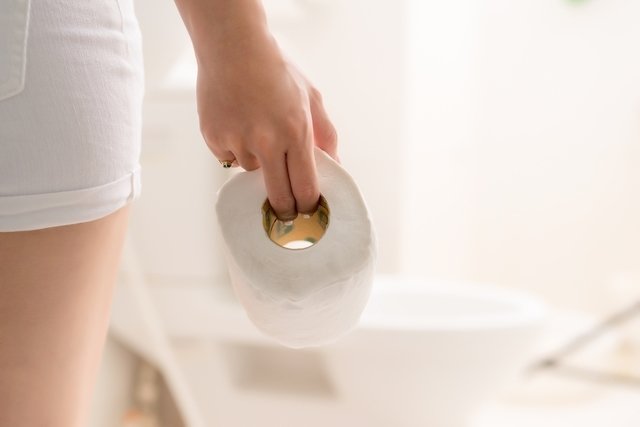External hemorrhoids are dilated veins that exit the anus, causing anal pain, itching, bleeding during bowel movements and the presence of a small lump in the anus.
External hemorrhoids occur mainly due to excessive force to evacuate, being common in people who suffer from chronic constipation. However, they can also be caused by standing for a long time, physical inactivity, obesity and pregnancy.
It is important that the doctor is consulted so that the hemorrhoids can be assessed and the best treatment can be indicated, which may involve the use of anesthetic ointments. Learn more about hemorrhoids in the following video:
Symptoms of external hemorrhoids
The main symptoms of external hemorrhoids are:
- Sharp pain in the anal region which worsens when evacuating and sitting;
- Itch in the anus due to the release of mucus and small particles of feces;
- Palpation of one or more nodules or balls in the anus;
- Small bleeding after straining to evacuate.
Most of the time, external hemorrhoids also bleed due to trauma to the vein during the passage of feces or when cleaning the area with toilet paper. In this case, you should always wash the area after having a bowel movement, with soap and water, to reduce symptoms and thus achieve improvement more quickly.
How to confirm the diagnosis
The diagnosis of external hemorrhoids must be made by a proctologist or gastroenterologist, based on observation of the anal region, where the presence of dilated veins can be observed.
Taking care of your health has never been easier!
Main causes
External hemorrhoids can be caused by:
- Excessive effort to evacuate, due to constipation, for example;
- Obesity;
- Pregnancy;
- Effort during labor;
- Lifting or carrying a lot of weight regularly.
In these situations, there is usually an increase in pressure in the abdomen, which can cause dilated veins to appear in the anus region, leading to the development of external hemorrhoids. See more causes of hemorrhoids.
Furthermore, external hemorrhoids are more common in older people who spend a lot of time standing and in cases of sedentary lifestyle, prolonged diarrhea, constipation and a family history of hemorrhoids.
How the treatment is carried out
Treatment for external hemorrhoids is usually done by taking a warm sitz bath, which helps to relieve pain and discomfort in the region. In addition, your doctor may advise you to apply hemorrhoid ointments and changes in your diet to alleviate symptoms and allow the hemorrhoid to improve.
In more serious cases or when symptoms persist despite initial measures, surgery may be indicated to permanently remove the hemorrhoid. Understand better how external hemorrhoids are treated.
Diet changes
Dietary changes are recommended to treat external hemorrhoids, facilitating evacuation and allowing the dilated veins to return to normal. It is recommended to increase the amount of fiber in your diet, eating more fruits and vegetables, for example, and drinking more water during the day. Find out what your diet should be like in case of hemorrhoids.
External hemorrhoid ointment
Ointments with anesthetics and corticosteroids in their composition are normally indicated to relieve the pain and discomfort of external hemorrhoids. Discover more ointments for hemorrhoids.
Hemorrhoid surgery
Surgery for external hemorrhoids may be indicated in some cases, especially when the hemorrhoid does not improve with initial treatment, and does not always involve removal of the hemorrhoid, called hemorrhoidectomy. See how hemorrhoid surgery is performed.
Bibliography
- LOHSIRIWAT, Varut. Treatment of hemorrhoids: A coloproctologist's view. World J Gastroenterol. Vol.21, n.31. 9245-52, 2015
- STATPEARLS. External Hemorrhoid. 2022. Available at: <https://www.ncbi.nlm.nih.gov/books/NBK500009/>. Accessed on March 1, 2023
- COHEE, Mark W; HURFF, Ashlee; GAZEWOOD, John D. Benign Anorectal Conditions: Evaluation and Management. American Family Physician. Vol.101, n.1. 24-33, 2020
- HARVARD HEALTH PUBLISHING. Hemorrhoids and what to do about them. 2019. Disponível em: <https://www.health.harvard.edu/diseases-and-conditions/hemorrhoids_and_what_to_do_about_them>. Acesso em 26 jul 2021
- VARUT, Lohsiriwat. Hemorrhoids: From basic pathophysiology to clinical management. World Journal of Gastroenterology. 18. 17; 2009–2017, 2012
- STAROSELSKY, A.; et al. Hemorrhoids in pregnancy. Can Fam Physician. 54. 2; 189-90, 2008
- NATIONAL INSTITUTES OF HEALTH. Treatment of Hemorrhoids. Disponível em: <https://www.niddk.nih.gov/health-information/digestive-diseases/hemorrhoids/treatment>. Acesso em 26 jul 2021
- MOTT, T.; LATIMER, K.; EDWARDS, C. Hemorrhoids: Diagnosis and Treatment Options. Am Fam Physician. 97. 3; 172-179, 2018
- PHILLIPS, R.K.S; CLARK, S. Colorectal Surgery. 5 ed. Rio de Janeiro: Elsevier, 2017. 231-236.





